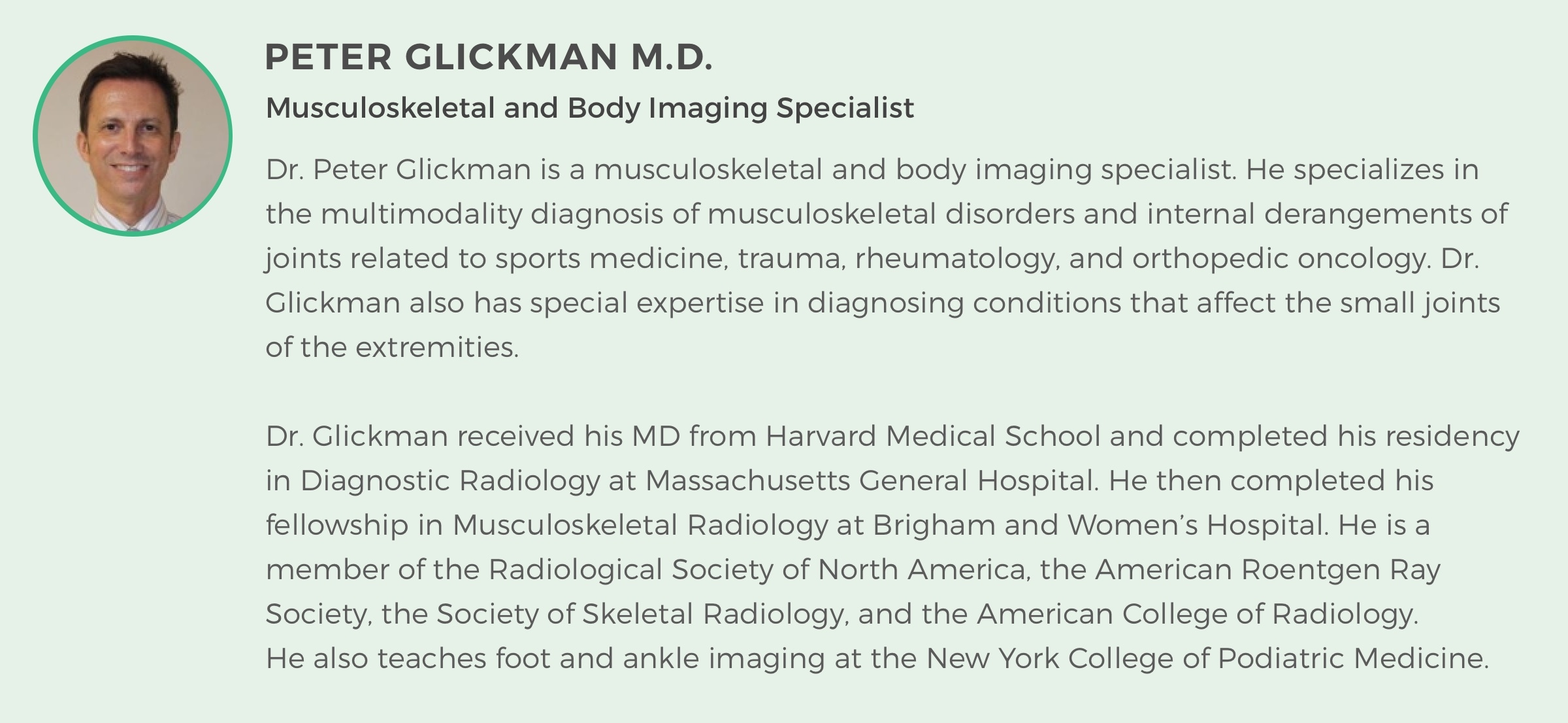If you’ve been experiencing shoulder pain, or have had a recent shoulder injury, you may have likely gotten a shoulder MRI.
A shoulder MRI is a powerful tool with a superior ability to produce detailed pictures of the bones, tendons, muscles, and blood vessels within the shoulder joint. The images help radiologists detect a variety of conditions and are an important step in determining when surgery is necessary. But shoulder MRI scans are difficult to read, requiring radiologists to put together the information provided in each mage to decipher normal wear and tear from an injury or other type of abnormality. This requires a lot of training and expertise that develops with experience.
We spoke with Dr. Glickman, Harvard trained Musculoskeletal and Body Imaging Specialist, to learn why getting a second opinion on your shoulder MRI is so important. From commonly misdiagnosed injuries to three reasons you should seek a second opinion, Dr. Glickman offers guidance to help patients ensure they get an accurate diagnosis.
DocPanel is committed to making sure every patient receives excellent care. If you would like an expert second opinion on your medical imaging from Dr. Glickman or one of our other fellowship-trained subspecialty radiologists, you can learn more here.
Three Reasons You Should Get a Second Opinion on Your Shoulder MRI
1. If surgery of any type is being recommended
[Dr. Glickman:] Surgery can be curative but is not without risk. The decision to go under the knife should always be made with care. Often, the way injuries are described in a radiology report will influence a surgeon as to whether surgery is indicated. So having your shoulder MRI interpreted by a subspecialty musculoskeletal radiologist is paramount to correct treatment planning. If a scan is read by someone without proper training, it may be misinterpreted which can result in serious consequences. Getting a second opinion with DocPanel provides patients an opportunity to have their shoulder MRI read by one of the nation’s top musculoskeletal radiologists. In some instances, it can mean the difference between your surgeon having the wrong or right information to help make life-changing decisions about your care.
For example, a recent full-thickness rotator cuff tear is usually surgical, whereas an old full-thickness tear may not be repairable, and a partial tear MAY be surgical especially if high grade, and in a location that correlates with the patient’s symptoms and physical exam. Only some labral or ligament tears will need or even be amenable to surgery, others not. If there is advanced arthritis of the glenohumeral joint, that will also be a consideration, since many types of surgical procedures are unlikely to be successful in that case. A precise description of all shoulder pathology in the report is therefore critical to determine if the risks of surgery are outweighed by the likely benefits.
2. Cancer or an "aggressive lesion" has been diagnosed
[Dr. Glickman:] An experienced subspecialty musculoskeletal radiologist can often characterize a bone or soft tissue lesion as either benign/don’t touch, benign/follow with imaging, or aggressive/malignant and needs further workup/biopsy/surgery. A generalist may likely not have the knowledge set required to accurately interpret these characterizations. Often, patients aren’t told who will be reading their scans. A second opinion allows one to take charge of their health by ensuring they have the correct specialist reading their shoulder MRI.
The correlation of an MRI with plain films or CT is also often crucial to the correct diagnosis. In many cases, current studies should be directly compared to older studies, which may definitively characterize a lesion as benign. This can help avoid the need for further workup and avert the anxiety this would cause the patient. DocPanel’s subspecialty radiologists know when it is appropriate to ask the patient for proper reports that may have not been initially incorporated in the initial shoulder MRI read.
CONNECT WITH A SPECIALIST
Get a Second Opinion
Take charge of your health with an online second opinion from a radiology specialist.
3. Your activities of daily living are being significantly affected by your symptoms or symptoms are not improving with the recommended treatment
[Dr. Glickman:] This includes if you have had surgery, but have not had an improvement after the healing period (in this case, obtaining pre-operative radiology studies for comparison by the radiologist to the current studies will be critical). It also includes however you define those activities – e.g. if you are a professional athlete, your athletic activities are more crucial to your livelihood than if you are a casual athlete. If you cannot do your routine activities without significant pain or feelings of shoulder instability, then you are more likely to be a surgical candidate and imaging should be reviewed carefully. When you get a second opinion, you can provide the radiologist with this information, so that they may interpret your shoulder MRI while considering these factors.
Also, in many cases, non-surgical therapies, such as calcium aspirations, steroid injections, or even injections of other agents such PRP, stem cells, or other similar new therapies may be excellent curative options. But these should only be pursued in the right kinds of cases. Getting a second opinion presents an opportunity to learn about new treatment recommendations, as a subspecialist can help equip your doctors with the information needed to make these important decisions. This is true for all musculoskeletal injuries.
Commonly misdiagnosed/overdiagnosed shoulder pathologies:
Unstable labral tears
[Dr. Glickman:] In a significant number of cases, this type of labral tear simply cannot be seen on a regular shoulder MRI, and a shoulder MR arthrogram (MRI following image-guided injection of contrast by a radiologist) is necessary. This is particularly important in patients under the age of 55, who are the most likely to benefit from surgical repairs. Especially if you are a young athlete with instability, an arthrogram will be significantly better than a non-contrast MRI. Many primary care providers may not be aware of this, although most specialists will know.
Adhesive capsulitis or "frozen shoulder"
[Dr. Glickman:] Community general radiologists may not be aware of the key diagnostic features of a shoulder MRI, and since this condition can often be cured by physical therapy or therapeutic injection, it is an important diagnosis to make.
Hydroxyapatite deposition or calcific tendonitis/bursitis
[Dr. Glickman:] Painful calcium deposits, which can be aspirated and cured with a needle procedure, may only be visible on X-rays (or if recommended, a CT scan), not MRI. Again, many non-subspecialty radiologists or other providers may not be aware of this. A subspecialty second opinion radiologist can help guide you on recommended additional imaging.
Advice for patients
[Dr. Glickman:] MRI exams are complex, and, because the risk of misdiagnoses is high when scans are not interpreted by someone with the correct expertise, it’s important patients get a second opinion. A routine X-ray study of the shoulder should also ALWAYS be done alongside a shoulder MRI. It should then be directly compared to the MRI for a complete diagnosis. Subspecialists know that this is an important step in the evaluation and can help ensure the full picture is taken into consideration and reported on.
MRI reports often list many things that may or may not have anything to do with the patient’s symptoms or problem. With DocPanel, you can ask the radiologist specific questions about your scan. This can help bring clarity for you and your doctors.
NEXT UP: Patient Story Feature – Hip Labral Tear Second Opinion – Patient Navigates Post Surgery Pain

